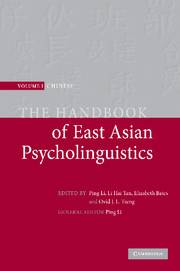Book contents
- Frontmatter
- Contents
- List of figures
- Notes on contributors
- Preface
- Introduction: new frontiers in Chinese psycholinguistics
- Part I Language acquisition
- Part II Language processing
- 14 Word-form encoding in Chinese speech production
- 15 Effects of semantic radical consistency and combinability on Chinese character processing
- 16 Eye movement in Chinese reading: basic processes and crosslinguistic differences
- 17 The Chinese character in psycholinguistic research: form, structure, and the reader
- 18 Perception and production of Mandarin Chinese tones
- 19 Phonological mediation in visual word recognition in English and Chinese
- 20 Reading Chinese characters: orthography, phonology, meaning, and the Lexical Constituency Model
- 21 Processing of characters by native Chinese readers
- 22 L2 acquisition and processing of Mandarin tones
- 23 The comprehension of coreference in Chinese discourse
- 24 Lexical ambiguity resolution in Chinese sentence processing
- Part III Language and the brain
- Epilogue: a tribute to Elizabeth Bates
- References
- Name index
- Subject index
16 - Eye movement in Chinese reading: basic processes and crosslinguistic differences
Published online by Cambridge University Press: 05 June 2012
- Frontmatter
- Contents
- List of figures
- Notes on contributors
- Preface
- Introduction: new frontiers in Chinese psycholinguistics
- Part I Language acquisition
- Part II Language processing
- 14 Word-form encoding in Chinese speech production
- 15 Effects of semantic radical consistency and combinability on Chinese character processing
- 16 Eye movement in Chinese reading: basic processes and crosslinguistic differences
- 17 The Chinese character in psycholinguistic research: form, structure, and the reader
- 18 Perception and production of Mandarin Chinese tones
- 19 Phonological mediation in visual word recognition in English and Chinese
- 20 Reading Chinese characters: orthography, phonology, meaning, and the Lexical Constituency Model
- 21 Processing of characters by native Chinese readers
- 22 L2 acquisition and processing of Mandarin tones
- 23 The comprehension of coreference in Chinese discourse
- 24 Lexical ambiguity resolution in Chinese sentence processing
- Part III Language and the brain
- Epilogue: a tribute to Elizabeth Bates
- References
- Name index
- Subject index
Summary
As the eyes travel through lines, they proceed with a series of jumps (saccades) and stops (fixations). These fixations and saccades reflect the underlying perceptual, cognitive, and linguistic processes during reading (Rayner, 1998). Eye movements in Chinese reading are particularly interesting because of the unique features of the Chinese language and orthography, many of which are discussed in other chapters of this handbook. The present chapter focuses on how these orthography-specific characteristics affect eye movements in Chinese reading eye movement programming.
A brief history
The first published study of Chinese eye movement dates back to 1925 (Miles & Shen, 1925), almost a half century after the discovery of reading eye movements (Javel, 1878). Several studies were conducted in the following decade on topics related to the Chinese language reform movement at the time, which, among many things, promoted horizontal rather than vertical text arrangement, vernacular as opposed to classical writing styles, and silent reading over oral reading (Hu, 1928; Miles & Shen, 1925; Shen 1925; Wang, 1935). For example, Chinese was written primarily in the top-down writing direction. There were various speculations that vertical reading was inefficient because of physiological constraints, such as the shape of our eyes or the way two eyes are positioned (see Hoosain, 1991 and Miles & Shen, 1925). The first studies on Chinese reading eye movement disputed the popular misconception. Shen and colleagues demonstrated that vertical reading was slightly faster than horizontal reading (Miles & Shen, 1925; Shen, 1926, 1927).
- Type
- Chapter
- Information
- The Handbook of East Asian Psycholinguistics , pp. 187 - 194Publisher: Cambridge University PressPrint publication year: 2006
- 2
- Cited by



